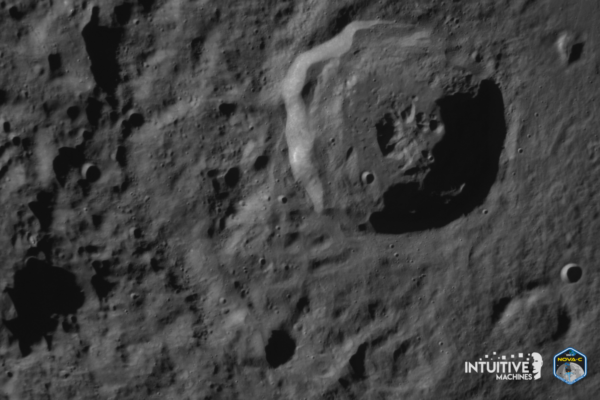Intuitive Machines will attempt a landing at the moon’s south pole, at the lunar feature known as Malapert A, Thursday at approximately 6:24 p.m.
NASA will be livestreaming the event starting at 5 p.m.
The intrepid spacecraft is poised to make spaceflight history as the first private spacecraft to safely land on the moon, and it will be the first U.S. spacecraft to land on the moon since Apollo 17 in December 1972.
The unmanned Nova-C lunar lander is called Odysseus, or Odie. It was launched last week on a Space-X Falcon 9 rocket at Kennedy Space Center in Florida.
Recent attempts to land on the moon by Japan, Russia, Israel and the U.S. resulted in crashes. Japan’s most recent attempt, SLIM, landed essentially upside down but was able to complete most of its science objectives and return pictures.
The U.S. lunar landing attempt by Astrobotic Technology’s Peregrine lunar lander, funded by NASA’s Commercial Lunar Payload Services (CLPS), happened just last month and ended when the spacecraft was destroyed when it entered Earth’s atmosphere.
Thursday is the second attempted lunar landing by a private spacecraft funded by NASA’s CLPS.
As explained by NASA, Odie is a product of NASA’s “CLPS initiative and Artemis campaign. Intuitive Machines’ first lunar mission will carry NASA science to the Moon to study plume-surface interactions, space weather/lunar surface interactions, radio astronomy, precision landing technologies, and a communication and navigation node for future autonomous navigation technologies.”
NASA Administrator Bill Nelson added, “NASA scientific instruments are on their way to the Moon — a giant leap for humanity as we prepare to return to the lunar surface for the first time in more than half a century. These daring Moon deliveries will not only conduct new science at the Moon, but they are supporting a growing commercial space economy while showing the strength of American technology and innovation. We have so much to learn through CLPS flights that will help us shape the future of human exploration for the Artemis Generation.”
While en route to the moon, NASA instruments will measure the quantity of cryogenic engine fuel as it is used. During descent toward the lunar surface, NASA will collect data on plume-surface interactions and test precision landing technologies, according to the space administration.

Once on the moon, NASA instruments will focus on investigating space weather/lunar surface interactions and radio astronomy. The Nova-C lander also will carry retroreflectors, contributing to a network of location markers on the moon for communication and navigation for future autonomous navigation technologies, NASA said.
NASA said science aboard the lander includes:
- Lunar Node 1 Navigation Demonstrator: A small, CubeSat-sized experiment that will demonstrate autonomous navigation that could be used by future landers, surface infrastructure and astronauts, digitally confirming their positions on the moon relative to other spacecraft, ground stations or rovers on the move.
- Laser Retroreflector Array: A collection of eight retroreflectors that enable precision laser ranging, which is a measurement of the distance between the orbiting or landing spacecraft to the reflector on the lander. The array is a passive optical instrument and will function as a permanent location marker on the moon for decades to come.
- Navigation Doppler Lidar for Precise Velocity and Range Sensing: A Lidar-based (Light Detection and Ranging) guidance system for descent and landing. This instrument operates on the same principles of radar but uses pulses from a laser emitted through three optical telescopes. It will measure speed, direction, and altitude with high precision during descent and touchdown.
- Radio Frequency Mass Gauge: A technology demonstration that measures the amount of propellant in spacecraft tanks in a low-gravity space environment. Using sensor technology, the gauge will measure the amount of cryogenic propellant in Nova-C’s fuel and oxidizer tanks, providing data that could help predict fuel usage on future missions.
- Radio-wave Observations at the Lunar Surface of the Photoelectron Sheath: The instrument will observe the moon’s surface environment in radio frequencies, to determine how natural and human-generated activity near the surface interacts with and could interfere with science conducted there.
- Stereo Cameras for Lunar Plume-Surface Studies: A suite of four tiny cameras to capture imagery showing how the moon’s surface changes from interactions with the spacecraft’s engine plume during and after descent.
NASA’s still-active Lunar Reconnaissance Orbiter (LRO) has been in lunar orbit since 2009 and has documented each successful and crash landing that has taken place.
Follow Greg Redfern on Facebook, X @SkyGuyinVA and his daily blog to keep up with the latest news in astronomy and space exploration.
Get breaking news and daily headlines delivered to your email inbox by signing up here.
© 2024 WTOP. All Rights Reserved. This website is not intended for users located within the European Economic Area.







